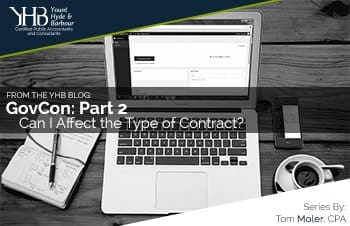 GovCon: Part 2
GovCon: Part 2Can I Affect the Type of Contract?
The short answer is, yes. However, there are a variety of circumstances and key factors that should go into your decision. It should be clear that performing services for the government requires you to be operating under a contract, a legal binding document, which defines the agreement between the purchaser (U.S. Government) and the seller (You). The type of contract utilized depends upon the nature of the contracted good and services, as well as the procuring agency’s needs.
There are different meanings for “contract types”. The term usually signifies different compensation arrangements, and these are numerous, but most of them fall into two major groups: fixed price or cost reimbursement.
These contract types vary in their degree of risk assumed by each of the parties. Firm Fixed Price (FFP) contracts have a lower risk for the buyer, and a higher risk for the seller. On the other end of the risk spectrum are Time and Materials (T&M) and Labor Hours (LH) contracts, shifting the risk to the buyer and away from the seller.
Government vs. Seller Contract Terms
A general understanding of the government’s incentives and approach will only help you in your contract negotiation efforts. First of all, the Federal government sets out the type of contract in the terms and conditions of the solicitation. In non-competitive procurements, and in a limited number of negotiated procurements, the contractor may have an opportunity to propose a contract type. The contract type needs to provide the contractor an incentive to perform efficiently and effectively deliver the procured goods or services.
The Contracting Officer (CO) is responsible for selecting the appropriate contract type, however, the requirements initiator is usually responsible for drafting the technical/performance requirements in the Statement of Work (SOW). The level of detail and clarity of the expectations in the SOW drive the conditions of the contract, including pricing structure, payment terms and the amount of contract administration. The more easily the Government can articulate its needs accurately, the greater likelihood that the contractor will accept more performance and cost risk.
Questions to Consider
In determining whether or not a contract would be a good fit for you, you should be able to answer the following questions:
-
What are the risks associated with performing the contract?
-
Can we do the job?
-
What are the work order’s technical, environmental, regulatory and financial risks?
-
Can we fit the work into our scheduling pipeline?
-
Can we properly estimate the amount and type of labor hours required?
-
Can we estimate any equipment or materials needed?
A good understanding of the risk factors of the contract is necessary for success. The complexity of the contract, the urgency of the contract and the period of performance should all be considered. If the objective is urgent, the government will have to assume a greater component of the risk, or offer incentives to ensure timely performance. A longer period of performance means that more unknowns exist and it is difficult for both parties to cover all contingencies in performance. The longer the time period, the budget levels increase. In this case it may be beneficial to seek some type of economic price adjustment terms or a re-pricing mechanism.
If you win the contract, but cannot perform it alone, you will need to evaluate each of your ‘partnering’ or ‘teaming’ firms to determine who best fits the needs of the contract.
Contract Type Categories
Compensation Type
There are many variations on the firm-fixed price model, but here are the most common utilized:
-
Firm-Fixed Price Contracts (FFP)
-
Fixed Price with Economic Price Adjustments (FPEPA)
-
Fixed-Price Incentive Contracts (FPI)
Variations have also developed under the cost-reimbursement contracts, whereby the contractor strives to perform the contract within the estimated amount.
-
Cost Contracts
-
Cost-Sharing Contracts
-
Cost Plus Incentive Fee (CPIF)
-
Cost Plus Award Fee (CPAF)
-
Cost Plus Fixed Fee (CPFF)
Structure Type
Below are a few of those that don’t fall easily into the two primary categories:
-
Performance Based Contracts (PB)
-
Indefinite Delivery Indefinite Quantity Contracts (IDIQ)
-
Time and Materials & Labor Hour Contracts (T&M)
-
Blanket Purchase Agreements (BPA)
-
Task Orders
***
This article is part 2 of a 4 part series. We will explore the further attributes of different contract types in future articles. If you would like to discuss your current or future contracts and how they may affect the company’s finances, please contact YHB Principal Tom Moler attom.moler@yhbcpa.com or 703-777-7739.
 Tom joined YHB in 1984 and served on the firm’s board of directors. As a principal of the firm in its Leesburg office, He specializes in providing accounting, tax and business consulting to closely held companies, corporations, partnerships and limited liability companies. He champions our Professional Services Firm niche and our Government Contracting niche. Tom has received recognition for his superior skills from several organizations, including the “Super CPA” designation from Virginia Business Magazine. He is a past Chairman and currently serves on the board of directors, executive and GovCon committee of the Loudoun County Chamber of Commerce. Tom earned a bachelor’s degree in accounting from Shepherd University.
Tom joined YHB in 1984 and served on the firm’s board of directors. As a principal of the firm in its Leesburg office, He specializes in providing accounting, tax and business consulting to closely held companies, corporations, partnerships and limited liability companies. He champions our Professional Services Firm niche and our Government Contracting niche. Tom has received recognition for his superior skills from several organizations, including the “Super CPA” designation from Virginia Business Magazine. He is a past Chairman and currently serves on the board of directors, executive and GovCon committee of the Loudoun County Chamber of Commerce. Tom earned a bachelor’s degree in accounting from Shepherd University.


